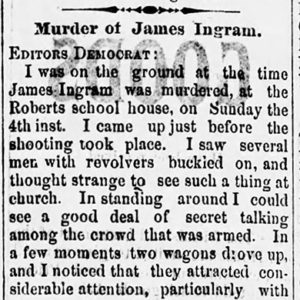calsfoundation@cals.org
James M. Ingram (1826–1870)
aka: James M. Ingraham
James M. Ingram was a Confederate guerrilla chieftain during the Civil War who, like William “Buck” Brown, operated in northwestern Arkansas. Ingram survived the war only to be assassinated five years after its end by the son of a man he killed.
James Ingram was born in Illinois in 1826 to Pleasant and Belinda Ingram. By 1848, he was living in Benton County, Arkansas, where he married Amanda Graham; they had four children. After she died around 1855, he married Sara Elizabeth Easley, with whom he would have five children.
Ingram was farming in Benton County when the Civil War began, and he formed a home guard company at some point before the Battle of Pea Ridge in March 1862. After the majority of the Confederate army moved east of the Mississippi River following the loss at Pea Ridge, Ingram was ordered to “proceed (with horses) to Memphis and report to General [Earl] Van Dorn,” but he ignored the order and remained in northwestern Arkansas to lead a guerrilla band.
He soon became an enemy and target of the First Arkansas Cavalry Regiment (US), as he and his men preyed on Union wagon trains, mail carriers, and stragglers from Federal outposts. During the Frog Bayou Expedition, a detachment from the First Arkansas attacked him and thirty or forty of his followers as they sheltered in a cave on the White River on November 15, 1862, but they escaped, with Lieutenant Colonel Albert Bishop reporting that Ingram lost “two…killed, five wounded, and five horses and nine guns…taken.” The Union officer leading the attack, however, wrote that they only succeeded in “dispersing them and taking a number of horses.” Colonel Marcus LaRue Harrison reported that “the notorious J. M. Ingraham” then joined Colonel William Brooks’s troops in falling back from the area.
In February 1863, Ingram, described as “the Captain of the most notorious of these [guerrilla] bands that infest Benton County,” sent a letter written in red ink “or possibly a liquid more sanguineous” to Bishop in Fayetteville (Washington County) in which he warned that “you should be carful for you hav give orders to murder inosent unarm men and Burn if you dont mind you will not Be forgot after peace.”
Ingram continued operating in Benton and Washington counties and was a target of the Union scout from Cassville, Missouri, to Cross Hollows in June 1864, with the Federal officer in charge reporting the guerrilla and his band were watching for opportunities to attack wagon trains. Ingram survived the war, and the Weekly Arkansas Gazette reported that “Capt. Ingram, with 30 or 40 men, surrendered” on May 31, 1865.
After the war, Ingram became a self-taught Baptist preacher, and the Fayetteville Weekly Democrat reported that “since the close of the war, had been living [as] a quiet and peaceable citizen, endeavoring to make a support for his helpless family.”
On September 4, 1870, Ingram and his family went to the Roberts school house in Washington County to attend a church service. John Stone, who was about seventeen years old and whose father Ingram’s band had hanged in 1864, pulled a pistol and fired at Ingram, who a witness said initially hid behind a horse, but then fled when Stone fired again, “the ball striking Ingram in the back, killing him almost instantly.” Stone escaped and apparently was never prosecuted for “the diabolical murder of…Ingram.”
Ingram is buried at Lowell (Benton County) at the junction of Primrose and Phillips roads.
For additional information:
Beaver, Carole Dolisi. “James M. Ingram. Part 1: Cold-blooded Murderer or Kind-hearted Minister?” Benton County Pioneer 55, no. 2 (2010): 5–13.
Bishop, A. W. Loyalty on the Frontier: Sketches of Union Men of the South-West with Incidents and Adventures in Rebellion on the Border. Edited by Kim Allen Scott. Fayetteville: University of Arkansas Press, 2003.
“Foul Murder.” Fayetteville Weekly Democrat, September 10, 1870, p. 2.
Jones, Glenn. “Captain James M. Ingram, Partisan Ranger—Confederate States of America, 1861–1865, Part 2.” Benton County Pioneer 55, no. 3 (2010): 14–16.
“Murder of James Ingram.” Fayetteville Weekly Democrat, September 17, 1870, p. 3.
Prier, Jay Anthony. “Under the Black Flag: The Real War in Washington County, 1861–1865.” MA thesis, University of Arkansas, 1992.
“State News.” Arkansas Gazette, September 20, 1870, p. 4.
“The Very Latest.” Weekly Arkansas Gazette, June 3, 1865, p. 3.
The War of the Rebellion: A Compilation of the Official Records of the Union and Confederate Armies, Series I, Vol. 13, p. 800. Washington DC: Government Printing Office, 1885.
The War of the Rebellion: A Compilation of the Official Records of the Union and Confederate Armies, Series I, Vol. 22, part 1, p. 751. Washington DC: Government Printing Office, 1888.
The War of the Rebellion: A Compilation of the Official Records of the Union and Confederate Armies, Series I, Vol. 34, part 1, p. 1041. Washington DC: Government Printing Office, 1891.
Mark K. Christ
Central Arkansas Library System
 Civil War through Reconstruction, 1861 through 1874
Civil War through Reconstruction, 1861 through 1874 Military
Military James Ingram Murder Article
James Ingram Murder Article 




I hope to visit the site since I am a descendent of James M. Ingram. The history interested me to no end.